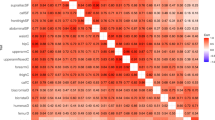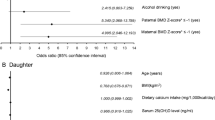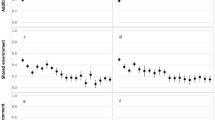Abstract
The purpose of this study was to determine the genetic and environmental correlations between weight, lean mass and bone geometric parameters (sub-periosteal diameter, W; cross-sectional area, CSA; cortical thickness, CT; section modulus, Z; and buckling ratio, BR) of femoral neck. The sample was composed of 512 Caucasian pedigrees, including 2667 females and 1822 males. Bivariate quantitative genetic analyses were performed to evaluate the genetic (ρ G ), environmental (ρ E ) and phenotypic (ρ P ) correlations between the study traits. Univariate genetic analyses showed that the heritabilities (h 2) for bone geometric parameters were significant (P < 0.001) ranging from 0.50 to 0.60. The significant common household effects indicated the common environment shared by household members for W, CSA, CT, Z and BR (P < 0.05), but the magnitude was small compared with heritabilities. ρ E , ρ G and ρ P between bone geometric parameters and weight, lean mass were generally significant. Interestingly, lean mass showed both stronger genetic and environmental correlations with the bone geometric parameters than weight. In addition, according to the magnitude of correlation coefficients, the ρ G between body compositions and bone geometric parameters were generally stronger thanρ E (except for that between BR and body compositions). These data suggested that the geometric parameters of femoral neck are under strong genetic control. Furthermore, some common genetic and environmental factors are shared by bone geometric parameters and weight, lean mass. The results may help understand the intertwined relationships between bone metabolisms, mechanical loading and body compositions.
Similar content being viewed by others


References
Kannus P, Parkkari J, Sievanen H, Heinonen A, Vuori I, Jarvinen M (1996) Epidemiology of hip fractures. Bone 18:57S–63S
Faulkner KG, Cummings SR, Black D, Palermo L, Gluer CC, Genant HK (1993) Simple measurement of femoral geometry predicts hip fracture: the study of osteoporotic fractures. J Bone Miner Res 8:1211–1217
Ammann P, Rizzoli R (2003) Bone strength and its determinants. Osteoporos Int 14:S13–S18
Melton LJ 3rd, Beck TJ, Amin S, Khosla S, Achenbach SJ, Oberg AL, Riggs BL (2005) Contributions of bone density and structure to fracture risk assessment in men and women. Osteoporos Int 16:460–467
Wolff J (1986) The law of bone remodeling [translated from the 1892 original, Das Gesetz der Transformation der Knochen, by P. Maquet and R. Furlong]. Springer Verlag, Berlin
Beck TJ, Looker AC, Ruff CB, Sievanen H, Wahner HW (2000) Structural trends in the aging femoral neck and proximal shaft: analysis of the Third National Health and Nutrition Examination Survey dual-energy X-ray absorptiometry data. J Bone Miner Res 15:2297–2304
Burr DB (1997) Muscle strength, bone mass, and age-related bone loss J Bone Miner Res 12:1547–1551
van der Meulen MC, Moro M, Kiratli BJ, Marcus R, Bachrach LK (2000) Mechanobiology of femoral neck structure during adolescence. J Rehabil Res Dev 37:201–208
Petit MA, Beck TJ, Shults J, Zemel BS, Foster BJ, Leonard MB (2005) Proximal femur bone geometry is appropriately adapted to lean mass in overweight children and adolescents. Bone 36:568–576
Fabsitz RR, Sholinsky P, Carmelli D (1994) Genetic influences on adult weight gain and maximum body mass index in male twins. Am J Epidemiol 140:711–720
Deng HW, Lai DB, Conway T, Li J, Xu FH, Davies KM, Recker RR (2001) Characterization of genetic and lifestyle factors for determining variation in body mass index, fat mass, percentage of fat mass, and lean mass. J Clin Densitom 4:353–361
van Rossum CT, Hoebee B, van Baak MA, Mars M, Saris WH, Seidell JC (2003) Genetic variation in the leptin receptor gene, leptin, and weight gain in young Dutch adults. Obes Res 11:373–374
Liu YJ, Xiao P, Xiong DH, Recker RR, Deng HW (2005) Searching for obesity genes: progress and prospects. Drugs Today (Barc) 41:345–362
Slemenda CW, Turner CH, Peacock M, Christian JC, Sorbel J, Hui SL, Johnston CC (1996) The genetics of proximal femur geometry, distribution of bone mass and bone mineral density. Osteoporos Int 6:178–182
Shen H, Long JR, Xiong DH, Liu YJ, Liu YZ, Xiao P, Zhao LJ, Dvornyk V, Zhang YY, Rocha-Sanchez S, Liu PY, Li JL, Deng HW (2005) Mapping quantitative trait Loci for cross-sectional geometry at the femoral neck. J Bone Miner Res 20:1973–1982
Deng HW, Shen H, Xu FH, Deng HY, Conway T, Zhang HT, Recker RR (2002) Tests of linkage and/or association of genes for vitamin D receptor, osteocalcin, and parathyroid hormone with bone mineral density. J Bone Miner Res 17:678–686
Martin RB, Burr DB (1984) Non-invasive measurement of long bone cross-sectional moment of inertia by photon absorptiometry. J Biomech 17:195–201
Filardi S, Zebaze RM, Duan Y, Edmonds J, Beck T, Seeman E (2004) Femoral neck fragility in women has its structural and biomechanical basis established by periosteal modeling during growth and endocortical remodeling during aging. Osteoporos Int 15:103–107
Xiong DH, Shen H, Guo YF, Long JR, Zhao LJ, Liu YZ, Deng HW (2005) A large genome scan identified QTLs and epistatic interactions underlying femoral neck cross-sectional geometry that is significant for osteoporosis. JBone Miner Res in press
Beck T (2003) Measuring the structural strength of bones with dual-energy X-ray absorptiometry: principles, technical limitations, and future possibilities. Osteoporos Int 5(14 Suppl):81–88
Comuzzie AG, Blangero J, Mahaney MC, Mitchell BD, Stern MP, MacCluer JW (1994) Genetic and environmental correlations among skinfold measures. Int J Obes Relat Metab Disord 18:413–418
Williams JT, Begleiter H, Porjesz B, Edenberg HJ, Foroud T, Reich T, Goate A, Van Eerdewegh P, Almasy L, Blangero J (1999) Joint multipoint linkage analysis of multivariate qualitative and quantitative traits. II. Alcoholism and event-related potentials. Am J Hum Genet 65:1148–1160
Comuzzie AG, Rainwater DL, Blangero J, Mahaney MC, VandeBerg JL, MacCluer JW (1997) Shared and unique genetic effects among seven HDL phenotypes. Arterioscler Thromb Vasc Biol 17:859–864
Ahlborg HG, Johnell O, Turner CH, Rannevik G, Karlsson MK (2003) Bone loss and bone size after menopause. N Engl J Med 349:327–334
Xiong DH, Liu YZ, Liu PY, Zhao LZ and Deng HW (2005) Association analysis of estrogen receptor α gene polymorphisms with cross-sectional geometry of the femoral neck in Caucasian nuclear families. Osteoporosis Int in press
Arden NK, Spector TD (1997) Genetic influences on muscle strength, lean body mass, and bone mineral density: a twin study. J Bone Miner Res 12:2076–2081
Brown WM, Beck SR, Lange EM, Davis CC, Kay CM, Langefeld CD, Rich SS (2003) Framingham Heart Study. Age-stratified heritability estimation in the Framingham Heart Study families. BMC Genet 4:S32
Bechtold S, Ripperger P, Bonfig W, Pozza RD, Haefner R, Schwarz HP (2005) Growth hormone changes bone geometry and body composition in patients with juvenile idiopathic arthritis requiring glucocorticoid treatment: a controlled study using peripheral quantitative computed tomography. J Clin Endocrinol Metab 90:3168–3173
Baum HB, Biller BM, Finkelstein JS, Cannistraro KB, Oppenhein DS, Schoenfeld DA, Michel TH, Wittink H, Klibanski A (1996) Effects of physiologic growth hormone therapy on bone density and body composition in patients with adult-onset growth hormone deficiency. A randomized, placebo-controlled trial. Ann Intern Med 125:883–890
Lang DH, Sharkey NA, Mack HA, Vogler GP, Vandenbergh DJ, Blizard DA, Stout JT, McClearn GE (2005) Quantitative trait loci analysis of structural and material skeletal phenotypes in C57BL/6J and DBA/2 second-generation and recombinant inbred mice. J Bone Miner Res 20:88–99
Rivadeneira F, Houwing-Duistermaat JJ, Beck TJ, Janssen JA, Hofman A, Pols HA, Van Duijn CM, Uitterlinden AG (2004) The Influence of an Insulin-Like Growth Factor I Gene Promoter Polymorphism on Hip Bone Geometry and the Risk of Nonvertebral Fracture in the Elderly: The Rotterdam Study. J Bone Miner Res 19:1280–1290
Kostek MC, Delmonico MJ, Reichel JB, Roth SM, Douglass L, Ferrell RE, Hurley BF (2005) Muscle strength response to strength training is influenced by insulin-like growth factor 1 genotype in older adults. J Appl Physiol 98:2147–2154
Barger-Lux MJ, Heaney RP, Hayes J, DeLuca HF, Johnson ML, Gong G (1995) Vitamin D receptor gene polymorphism, bone mass, body size, and vitamin D receptor density. Calcif Tissue Int 57:161–162
Heaney RP, Barger-Lux MJ, Davies KM, Ryan RA, Johnson ML, Gong G (1997) Bone dimensional change with age: interactions of genetic, hormonal, and body size variables. Osteoporos Int 7:426–431
Ferretti JL, Cointry GR, Capozza RF, Frost HM (2003) Bone mass, bone strength, muscle-bone interactions, osteopenias and osteoporoses. Mech Ageing Dev 124:269–279
Burger EH, Klein-Nulend J (1999) Mechanotransduction in bone—role of the lacuno-canalicular network. FASEB J 13:S101–S112
Lean JM, Jagger CJ, Chambers TJ, Chow JW (1995) Increased insulin-like growth factor I mRNA expression in rat osteocytes in response to mechanical stimulation. Am J Physiol 268:E318–327
Beck TJ, Oreskovic TL, Stone KL, Ruff CB, Ensrud K, Nevitt MC, Genant HK, Cummings SR (2001) Structural adaptation to changing skeletal load in the progression toward hip fragility: the study of osteoporotic fractures. J Bone Miner Res 16:1108–1119
Hamrick MW, McPherron AC, Lovejoy CO, Hudson J (2000) Femoral morphology and cross-sectional geometry of adult myostatin-deficient mice. Bone 27(3):343–349
Acknowledgments
The study was partially supported by grants from National Health Institute (K01 AR02170-01A2, R01 GM60402 and 5R01 AR050496-02). The study also benefited from grants from Natural Science Foundation of Hunan Province (05JJ40051, 04JJ1004), Scientific Research Funds of Hunan Provincial Education Department (05B037, 02A027, 03C226, and 04B039), a key project grant (30230210), and a general grant (30470534) from National Science Foundation of China, and Dickson Missouri Endowment.
Author information
Authors and Affiliations
Corresponding author
Additional information
Xiao Sun and Shu-Feng Lei contribute equally to this work
Rights and permissions
About this article
Cite this article
Sun, X., Lei, SF., Deng, FY. et al. Genetic and Environmental Correlations between Bone Geometric Parameters and Body Compositions. Calcif Tissue Int 79, 43–49 (2006). https://doi.org/10.1007/s00223-006-0041-3
Received:
Accepted:
Published:
Issue Date:
DOI: https://doi.org/10.1007/s00223-006-0041-3


